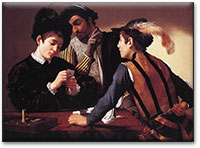| |
Hockney | Stork | Experts | Assumptions | Camera-obscura | Italians | Caravaggio | Camera | Inquisition | Mirror-lens | Conclusion | Notes
Caravaggio and the concave mirror lens
It remains puzzling nevertheless, why Caravaggio was still using the mirror-lens when both Barbaro and Cardano had already promoted the biconvex lens for enhancing the camera obscura effect (already earlier in the fifteenth century). Perhaps because the Inquisition jailed Cardano in 1570 and banned his writing, his work on the lens might not have been that readily available. But Barbaro’s book was published before Caravaggio was born and was, presumably, in circulation. Also Barbaro, it turns out, likely knew Titian quite well, and Titian was Peterzano’s teacher who was Caravaggio’s teacher. Yet Caravaggio must have been using a concave mirror-lens in the early 1590s because Baglione is very specific in the word mirror (uno specchio) and those small paintings do, indeed, have the squashed mirror-lens look about them. When did knowledge about how to use a concave mirror to project a camera obscura image first appear then? It seems to have been with Della Porta, who actually described, in his 1558 edition of Natural Magic, “how to use a concave mirror to project an image onto a piece of paper.”45 It is possible perhaps, that Caravaggio simply did not have the money for a biconvex lens. Caravaggio “in 1593 was still terribly poor and, according to Baglione, unable to sell the paintings he’d done.”46 Hockney suggests that it was Cardinal Del Monte who first gave Caravaggio a (expensive) biconvex lens. But wouldn’t a concave mirror also have been (expensive)? Maybe not, according to Charles Falco.
| |

Caravaggio's Cheats (c.1595). From this time on Caravaggio starts to regularly include more than one figure in his paintings.

|
Mirrors can be made from metal rather than glass. Metal is much softer than glass, so it requires less time to grind and polish, and when completed a metal mirror reflects light without requiring an additional shiny coating to be applied. … I was able to fabricate a concave mirror in 59 minutes with sufficient resolution for van Eyck to have produced his drawing of the Cardinal Albergati.47
< Previous Next >
|

